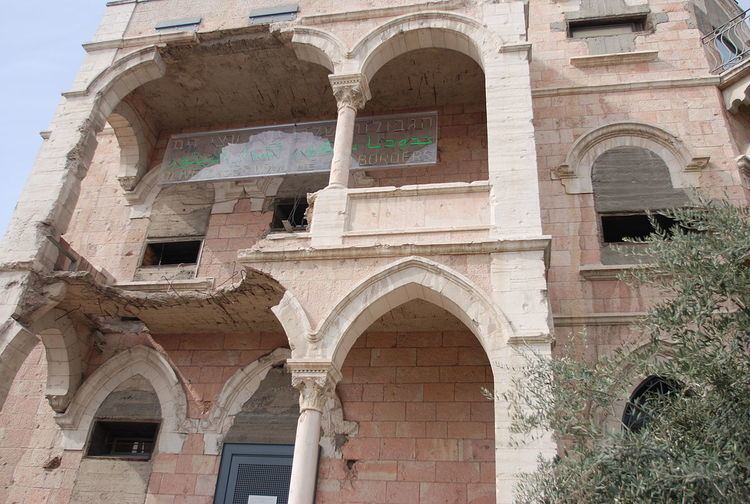Phone +972 2-628-1278 | Founded 2005 | |
 | ||
Hours Open today · 10AM–5PMWednesday10AM–5PMThursday10AM–5PMFriday10AM–2PMSaturdayClosedSundayClosedMonday10AM–5PMTuesday2–8PMSuggest an edit Similar Mandelbaum Gate, St George's Cathedral, Tombs of the Kings, Zedekiah's Cave, Rockefeller Museum | ||
Museum on the seam
The Museum on the Seam is a socio-political contemporary art museum in Jerusalem, Israel. Founded in 1999, it is housed in the home of the family of its original architect, Andoni Baramki, a Palestinian Arab whose property was appropriated by Israel after 1948. According to its website it focuses on "controversial social issues for public discussion,” with exhibitions on social issues like the right to protest, the decline of Western hegemony, and state/private home relationships. It has been lauded by The New York Times as one of the world's 29 cultural 'one must-see-before-I-die dedstinations.' According to its public presentations, it brings social and moral change in face of a complex and conflict-ridden reality.
Contents
The museum was initiated and established by Raphie Etgar who serves as its Artistic Director, and has been supported for some decades by the Holtzbrink Family Foundation. through the Jerusalem Foundation.
The various exhibitions displayed at the museum are participated by some of today's leading artists, such as: Anselm Kiefer, Bruce Nauman, Bill Viola, Christian Boltanski, Sophie Calle, Wim Wenders, Thomas Hirschhorn, Gilbert & George, Paul McCarthy, Barbara Kruger, Jenny Holzer, Douglas Gordon, William Kentridge, Santiago Sierra, Alfredo Jaar, Edward Burtynsky, Yael Bartana, Michal Rovner, Dani Karavan, Moshe Gershuni, Micha Ullman, Joshua Neustein, Larry Abramson, Sigalit Landau, Tsibi Geva, Menashe Kadishman, Miki Kratsman, Gilad Ophir, Michal Na'aman and many others.
Museum on the seam
Building
The museum is located in a neo-classical building; built as his home by the Christian-Arab Architect Andoni Baramki in 1932, on one dunam of property purchased from the Turjman Jerusalemite family in the Musrara district. The Baramki family was forced to flee as refugees, after a stray bullet almost killed his architect's wife while she was sitting in her living room, during the 1948 Palestinian exodus during the 1948 Arab–Israeli War that took place, and ended up in the Gaza Strip. Their home was turned into an Israeli military outpost, called the "Tourjman Post" situated on the border or No man's land between Israel and Jordan overlooking the Mandelbaum Gate, which served as the only passage between the two parts of the divided city at the time. The finely wrought window arches were filled with concrete to form turrets. During the battles of the 1967 War, the house suffered hits from shells and bullets which left their marks on the building and are apparent to this day. At war's end, the Baramki's crossed over with their keys and title-deeds but were rebuffed. As was also the case with the Turjmans, all efforts by Andoni, and his son Gabi Baramki, longtime President of Birzeit University in the West Bank, to return to and repossess the family home through recourse in Israeli courts failed. The reasons were various: it was claimed initially that the site was required for military security, then that it was in a hazardous state, in need of substantial repairs, and finally that it fell under Israeli laws in a united Jerusalem, and, despite their presence, the family were classified as absentee property owners. Gabi Baramki, and the latter was allowed only one visit, in 1999. Baramki regarded it as "stolen property".
In the year 1981 the military outpost was renovated and renamed as the "Tourjmnan Post Museum" commemorating the reunification of the city. The museum mounted exhibits of the guns, mortars and other weapons used in its defense.
In the year 1999 the building underwent change and a new permanent exhibition, calling for tolerance and mutual understating between people in the region, was displayed. On the day of its dedication, opened ostensibly as a site for 'peace, tolerance, . .dialogue, understanding and coexistence', Gabi Baramki turned up and, when a guard asked him to show his ticket, he refused, on the grounds it was his home. He was permitted entry after a brief altercation. Baramki discovered no mention of his father's role in building it, or of the family owners, - the exhibits emphasized its past as a lonely Israeli outpost in a dangerous area. The omission was subsequently corrected.
Since 2005, the building serves as a home to the Museum on the Seam- a Socio Political Contemporary Art Museum. The turbulent history of the building serves as silent testimony to the political changes that Jerusalem and the whole country of Israel underwent; from its function as a private residence of a Palestinian family, through its usage as an Israeli army outpost, and currently as a socio-political museum committed to create a dialogue and build bridges of understanding in this very place. Akin Ajaya seems a contradiction between the museum's ambitions and its origins, asking:'How can an institution campaign for coexistence and reconciliation when its existence is predicated on the very injustice that it seeks to challenge?' In December it was announced that the Holtzbrinck funding for the Museum was ending, and efforts were being made to find alternative funding to keep the museum open.
Exhibitions
In 2000 Museum on the Seam produces, as an initiative by Raphie Etgar, the exhibition COEXISTANCE: an international project that incorporates many leading poster designers from around the globe. The project was displayed in over 35 cities in different continents and called for mutual understanding between fellow nations and religions. Its global Journey was endorsed and supported by world leaders and thinkers.
